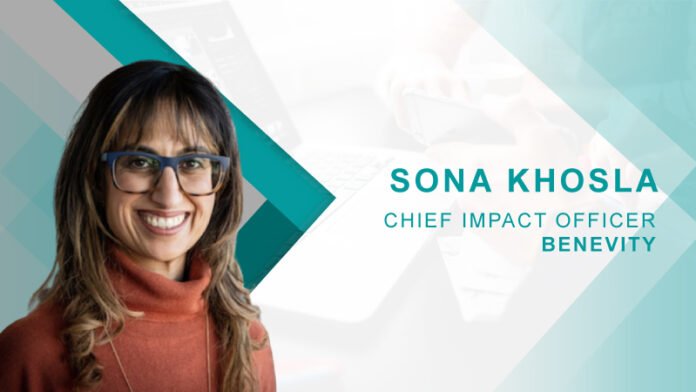Can you tell us about the concept of purpose and polarization going head-to-head? How do you think companies can effectively balance taking action on societal issues while navigating politically polarizing topics? How do you suggest companies strike the right balance?
The concept of purpose and polarization going head-to-head is top of mind for both business leaders and employees. Recent data from the State of Corporate Purpose 2023 trends report revealed that while 88% of corporate social responsibility (CSR) leaders believe companies should continue to take a stand, 71% of them also agree that companies should be cautious about the issues they support to avoid alienating stakeholders. This clearly indicates the difficult tension that companies find themselves in these days. Frankly, I wish there were a simple solution or playbook, but the reality is that each company will need to do what is right for their business and stakeholders and use that as a North Star to guide them through this period of uncertainty.
It will look different for every company. So the most important thing to do is reflect on the learnings from the past few years where brands were likely forced to take action on polarizing topics (like climate, Roe v. Wade, or the invasion of Ukraine). What did you do, what did you not do, what was your company’s tolerance level for risk versus standing up on an issue, what did your stakeholders expect and how did they react, how did you make difficult decisions, what did you learn about what works and what doesn’t, what were your measures of success? With this baseline in mind, identify the patterns that can be used for future decision-making. This will help you forge a path forward that is authentic to your brand, your people, and your business, helping you maintain trust as we navigate through a sustained period of heightened polarization.
Benevity’s annual State of Corporate Purpose report mentions the rise of “quiet giving” where companies are acting on social justice issues through their own practices and programs rather than making bold statements. What are some examples of effective “quiet giving” initiatives that you’ve come across?
“Quiet giving” is characterized by businesses shifting their focus from attention-grabbing, outwardly directed corporate statements that revolve around newsworthy matters towards placing more importance on investing in their employees and the communities they operate in. Companies that are embracing the quiet giving trend are doing this in a few different ways.
When it comes to employees, we are seeing companies amplify annual awareness dates like Pride with a bigger emphasis on employee- and ERG-driven events. This includes opportunities that promote learning and discussion about the issues, encouraging micro-actions, volunteering and acts of kindness, running matching campaigns, or giving ERGs funds to grant to nonprofits working towards the issue.
When it comes to making a difference in the communities that companies operate in, we are seeing more companies invest in local nonprofits, especially those that are BIPOC-led and/or are focused on mitigating the impacts of the economy on vulnerable populations.
Despite the economic downturn, companies are embracing the “quiet giving’ trend by investing in their communities and bringing employees together to learn, grow and make a positive impact.
According to the report, companies that focus on building a community into their culture are more successful in attracting and retaining top talent. Can you provide examples of companies that have successfully built a sense of community within their organizations? What were the key factors that contributed to their success?
One great example of a company focused on building a community into the fabric of its culture is Visa. A remarkable 80% of their 22,000+ global employees participated in Visa’s programs to give back to communities last year, which had positive effects on their connection to the company’s purpose and strategy, and pride in working for Visa. A few key elements of their program include a strong commitment to DEI&B (diversity, equity, inclusion, and belonging) for its people and also its devotion to global financial equity. Through a Visa Foundation grant and partnership with Kiva, all Visa employees are invited to participate in an annual program to direct a USD $50 loan to help increase financial access for underrepresented small businesses around the world.
Since the program began, Visa and Visa Foundation have directed $3.6 million in loans to 71,900+ SMBs in 40 countries, 88% of which are women-owned. Visa’s ability to empower their employees to support the communities in which they work and live has created more camaraderie between employees since they are able to rally around specific small businesses in markets close to them.
How can companies effectively integrate volunteering opportunities into their organizational culture to foster employee engagement and positive action?
Seventy-four percent of CSR leaders will be increasing their use of in-person volunteering around office locations to foster employee connection and combat hybrid work challenges, so it might just be that 2023 becomes the year of volunteering! Volunteering unites people, whether they are physically present or participating remotely, to join forces for a shared purpose and contribute to the community or causes that matter most to them.
Taking that into consideration, Benevity leverages volunteering within our own company as one of our greatest sources of connection, team-building, and community. For example, when people gather together for internal initiatives such as new employee onboarding, our annual week-long “Homecoming” gathering at Benevity headquarters, or major project launches, volunteering is the predominant way we do team building.
Through volunteering, both in person and virtually, we provide a way for our people to give back to their communities while also uniting our global workforce spread across 80 cities and 10 countries, including Canada, the United States, Europe, and Australia. Benevity’s Community Days, our latest company-wide volunteering event, involved community clean-ups, park improvements, and a clothing swap in celebration of Earth Day. Volunteering is a key component of Benevity’s social impact and employee engagement strategy, which saw an impressive 92% participation last year.
The report emphasizes the significance of employee resource groups (ERGs) in DEI strategies. Could you elaborate on the various benefits that ERGs offer, beyond enhancing a company’s DEI profile?
ERGs are a must-have strategy in DEI and a powerful source of business and employee value. The number one benefit they provide is the opportunity for employees to connect with, learn from, and support each other. In turn, they help foster a sense of belonging and improve overall company culture.
Through Benevity’s recent State of Workplace DEI report, we learned that 71% of employees have worked for a company that offers ERGs and 91% of these employees agree that ERGs have a greater impact on inclusivity in the workplace than traditional DEI trainings. This isn’t entirely surprising in light of research that proves that storytelling has a longer efficacy period than corporate training. Ultimately, ERGs establish a sense of community as an integral part of employees’ everyday experiences within a company, which is likely to generate a more profound and cumulative effect compared to organizing a one-time training event.
How can companies ensure that their ERGs are given adequate support and resources to fulfill their potential in terms of professional development, skills building, and growth opportunities?
There’s this misconception that companies can simply create an ERG and it will organically grow in all the right ways. That is not how it works. ERGs require (and deserve!) support and resources to flourish. This can look like executive-level sponsorship, funding for events, campaigns, sponsorships, or nonprofit grants, and clear roles and accountability, as well as an online platform to recruit and engage with their communities.
Because ERG leaders are often in voluntary positions, it’s important that companies set these folks up for success by clearly defining roles and expectations and supporting them in developing the skills to strategize, plan, communicate, and execute their ideas. Running an ERG, especially in a global company, can be a massive undertaking and will expose employees to new challenges including how to lead a cross-functional team, how to engage people in different departments or regions, and how to drive alignment within the group and amongst other ERGs. Other areas of professional development could stem from the need to recruit key members like communications and events leads, goal setting, tracking and measuring impact, budget management, evangelizing issues and communicating them publicly, and fostering a positive and inclusive culture. All of these are skills that set people up for leadership roles, so it’s not surprising that ERG leaders are often promoted to new jobs after their leadership term.
Most of all, ERGs need active and engaged members, which means that individual managers also play a critical role in supporting the success of ERGs by encouraging their people to join ERGs and participate in events on company time. Executive-level sponsorship helps ERGs maintain focus and gain momentum and membership while providing visibility for leaders and members of the group. Finally, funding plays a vital role in providing ERGs with the necessary financial resources to properly organize and execute events and make an impact in their communities.
How can companies ensure that their efforts to address social justice issues are authentic and meaningful, rather than just performative or superficial?
Employees and consumers are quick to notice and call out companies that make blanket statements without putting their money where their mouth is. To address the most pressing social justice issues in a meaningful and impactful way, companies need to have an always-on approach that empowers employees to address issues in a timely manner and in a variety of ways. This can be through matching employee donations to nonprofits that support racial and social justice and equity, encouraging and rewarding volunteering for these causes, giving ERGs a voice in company-wide communication channels and allowing them to play a role in culture-building activities, and countless other ways.
The key is for companies to focus on their actions before their communications. If they get clear on what actions they are taking first, they can communicate their support for these issues with much more credibility.
In your opinion, what role does leadership play in driving purposeful action within a company? How can leaders effectively inspire and engage employees in meaningful social impact initiatives?
If most leaders knew the value of social impact initiatives to their team’s success, they would likely invest more time thinking about how they could get their employees involved. Benevity’s Talent Retention Study found that companies see a 52% lower turnover rate among new employees who participate in CSR programs, indicating a powerful opportunity for managers to engage their people in doing good.
The most impactful way for leaders to inspire their people to get engaged is to act as role models by getting engaged themselves. This means showing up to volunteer events, actively participating in events organized by ERGs, and kick-starting their own fundraising and goodness initiatives that others can get involved in. Managers should also explicitly state support for their people using their matching or volunteer rewards and spending time to get involved in the company- or ERG-hosted events, volunteer opportunities, and individual volunteering. It is crucial that employees see their managers leading by example and feel their support and belief in doing good. This is what can make the difference between a culture that says it’s purpose-driven versus one that really is.
Looking ahead, what do you foresee as the future trends and challenges in the realm of corporate purpose and social impact, and how can companies prepare themselves to address them effectively?
Benevity’s 2023 State of Corporate Purpose Report offers a clear view of the challenges and opportunities for companies who want to remain purpose-driven despite the downturn in the economy.
Companies can prepare by considering how they can act as a unifying force for humanity in a world rife with polarization and division. At this time, it’s important that they support those closest to them–their employees and the communities in which they operate. As we navigate the challenges of hybrid work, companies should not miss out on the powerful opportunity to leverage volunteering to create a deeper sense of community amongst their employees. Those companies that go further and prioritize support for employee resource groups will reap a host of business and employee benefits. And finally, it’s imperative that companies continue to focus on purpose and positive impact as part of their long-term strategy.
If companies aren’t already thinking about these trends, they should be. Falling behind in any of these areas can lead to a negative impact on business, such as losing talent and customer loyalty, risking brand trust, and ultimately missing out on the power of purpose to create a more sustainable and resilient business that today’s workers and consumers will want to work for and buy from.
Discover the full potential of your Hrtech strategy with our comprehensive Hrtech News and Hrtech Interviews
Want to Contribute? CLICK HERE To Submit Your Guest Post and Join Our Community of Writers!!!

Sona Khosla Chief Impact Officer at Benevity
Sona Khosla is the Chief Impact Officer at Benevity, Inc., the leading provider of global corporate purpose software. At the helm of Benevity Impact Labs, the company’s social innovation hub, Sona and her team bring cutting-edge data, research, insights and best practices to help companies accelerate and maximize their impact and inclusion. She is also responsible for overseeing Benevity’s corporate purpose strategy. As the host of Benevity’s podcast, Speaking of Purpose, Sona is a frequent guest on shows and in the media discussing topics such as building purpose-driven brands, authentic employee and customer engagement, corporate giving trends and diversity, equity, inclusion, and belonging.












